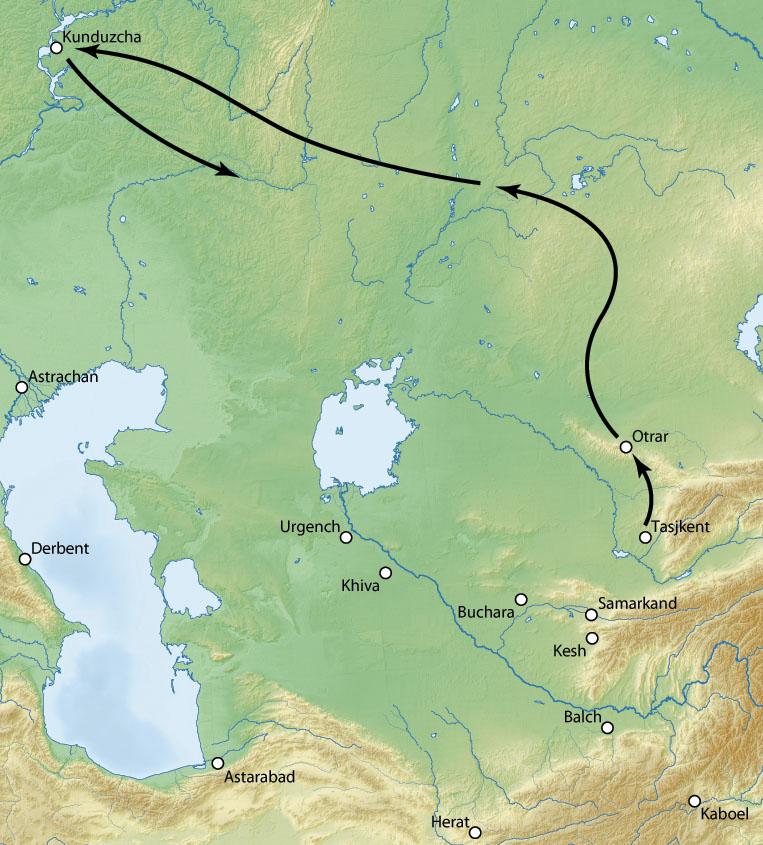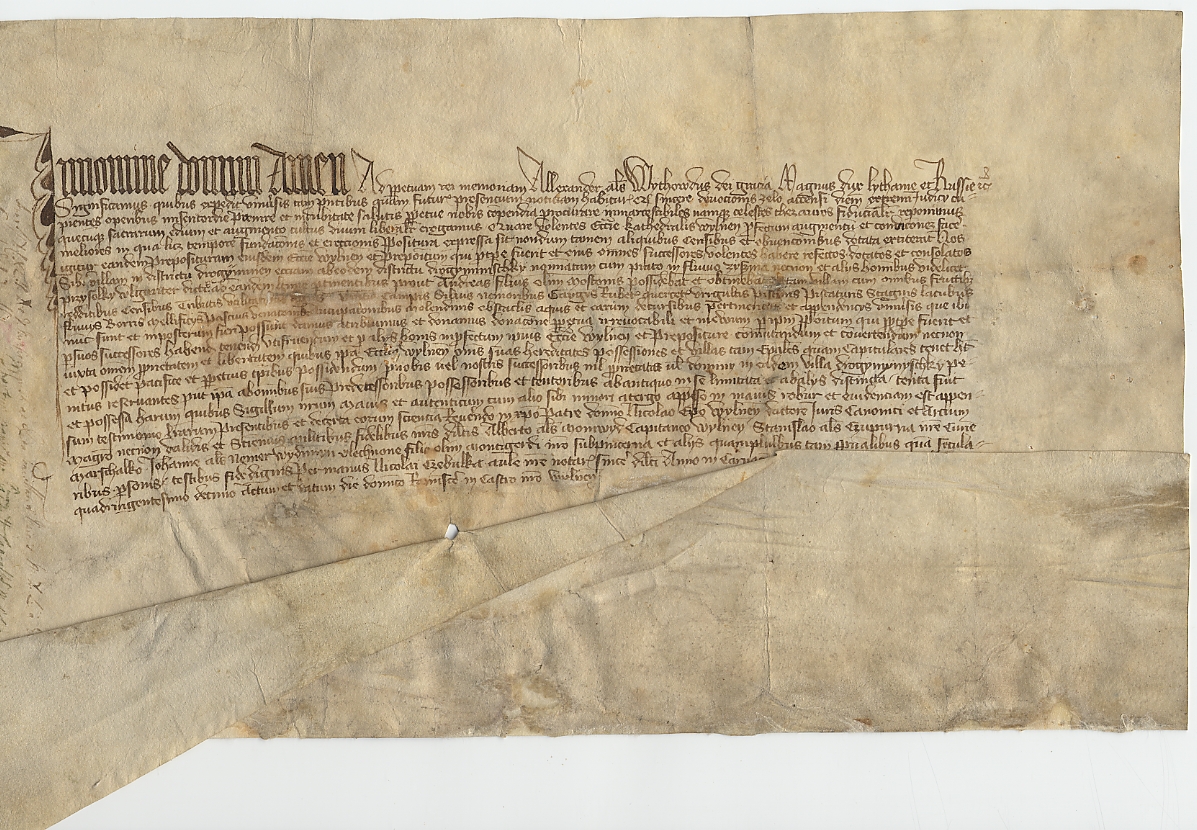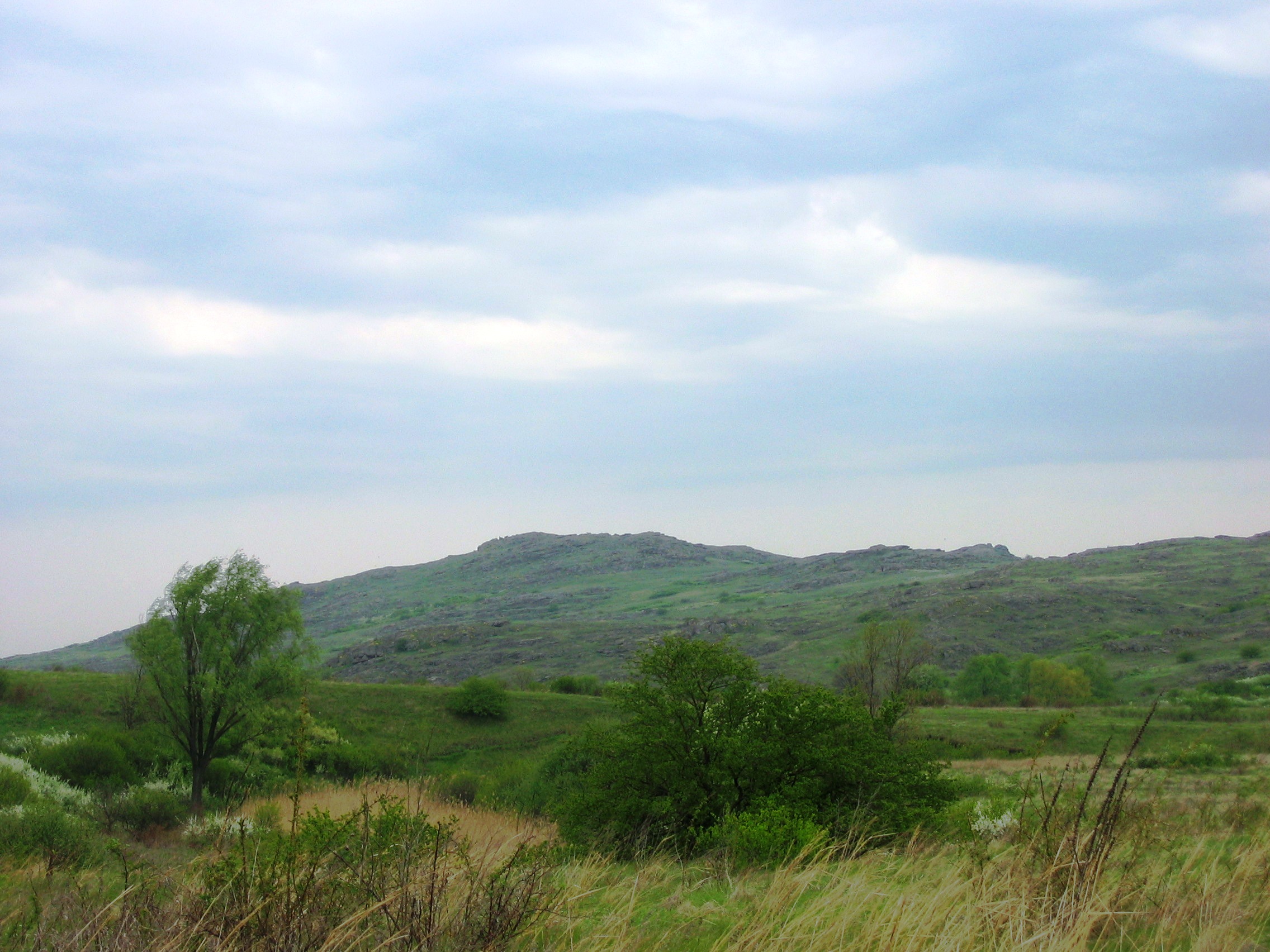|
Battle Of The Vorskla River
The Battle of the Vorskla River was fought on August 12, 1399, between the Tatars of the Golden Horde, under Edigu and Temür Qutlugh, and the armies of Tokhtamysh and a large Crusader force led by Grand Duke Vytautas the Great of Lithuania. The battle ended in a decisive Tatar victory for the Golden Horde. Background In late 1380s the relationship between Tokhtamysh, Khan of the Golden Horde, and his former master, Timur, was growing tense. In 1395, after losing the Tokhtamysh–Timur war, Tokhtamysh was dethroned by the party of Khan Temur Qutlugh and Emir Edigu, supported by Timur. Tokhtamysh escaped to the Grand Duchy of Lithuania and asked Vytautas for assistance in retaking the Horde in exchange for surrendering his suzerainty over Ruthenian lands. This development was in harmony with Vytautas' ambitions to become ruler of all Ruthenian lands. A surviving iarlyk shows that Tokhtamysh had asked for Polish–Lithuanian assistance previously in 1393. Vytautas' exp ... [...More Info...] [...Related Items...] OR: [Wikipedia] [Google] [Baidu] |
Tokhtamysh
Tokhtamysh ( Turki/ Kypchak and Persian: توقتمش; ; ; – 1406) was Khan of the Golden Horde from 1380 to 1395. He briefly succeeded in consolidating the Blue and White Hordes into a single polity. Tokhtamysh belonged to the House of Borjigin, tracing his ancestry to Genghis Khan. Spending most of his younger years fighting against his father's cousin Urus Khan and his sons, Tokhtamysh sought help from the Turco-Mongol warlord Timur, with whose help he succeeded in defeating his enemies. Tokhtamysh rose to power during a tumultuous period in the Golden Horde, which was severely weakened after a long period of division and internecine conflict. From a fugitive, Tokhtamysh had become a powerful monarch, quickly solidifying his authority in both wings of the Golden Horde. Encouraged by his success, as well as the growth of his manpower and wealth, Tokhtamysh went on a military expedition to the Russian principalities, sacking Moscow in 1382. He reasserted the Tatar–Mo ... [...More Info...] [...Related Items...] OR: [Wikipedia] [Google] [Baidu] |
Ruthenia
''Ruthenia'' is an exonym, originally used in Medieval Latin, as one of several terms for Rus'. Originally, the term ''Rus' land'' referred to a triangular area, which mainly corresponds to the tribe of Polans in Dnieper Ukraine. ''Ruthenia'' was used to refer to the East Slavic and Eastern Orthodox people of the Grand Duchy of Lithuania and the Kingdom of Poland, and later the Polish-Lithuanian Commonwealth and Austria-Hungary, mainly to Ukrainians and sometimes Belarusians, corresponding to the territories of modern Belarus, Ukraine, Eastern Poland and some of western Russia. Historically, in a broader sense, the term was used to refer to all the territories under Kievan dominion (mostly East Slavs). The Kingdom of Galicia and Lodomeria (1772–1918), corresponding to parts of Western Ukraine, was referred to as ''Ruthenia'' and its people as ''Ruthenians''. As a result of a Ukrainian national identity gradually dominating over much of present-day Ukraine in the 19t ... [...More Info...] [...Related Items...] OR: [Wikipedia] [Google] [Baidu] |
Temur Qutlugh
Timur, Temur, Temür, Temir, Teymur or Tömör is a masculine Turkic languages, Turkic and Mongolic languages, Mongolic given name which literally means ''iron''. It is a cognate of the Bosnian language, Bosnian and Turkish language, Turkish name Demir (other), Demir. In Indonesian, timur translates to ''east'', and symbolizes hope by the rising sun. Timur () is also a popular name for boys in former soviet countries, post-Soviet states, due in part to its usage in the novel ''Timur and His Squad'' by Arkady Gaidar. Notable people with the name include: People with the given name Historical * Mengu-Timur, Möngke Temür (d.1280), khan of the Golden Horde * Several rulers from the Chinese-Mongol Yuan Dynasty. ** Temür Khan ( 1294–1307), the second ruler of the Yuan dynasty ** Tugh Temür, better known as Jayaatu Khan, Emperor Wenzong of Yuan ( 1328–1332) ** Toghon Temür ( 1333–1370) ** Uskhal Khan Tögüs Temür ( 1378–1388) ** Yesün Temür Khan, Emperor Taid ... [...More Info...] [...Related Items...] OR: [Wikipedia] [Google] [Baidu] |
Tokhtamysh–Timur War
The Tokhtamysh–Timur war was fought from 1386 to 1395 between Tokhtamysh, the khan of the Golden Horde, and the warlord and conqueror Timur, founder of the Timurid Empire, in the areas of the Caucasus Mountains, Turkestan and Eastern Europe. The battle between Timur and Tokhtamysh played a key role in the decline of Mongol power over the Russian principalities. Background In the late 1370s and early 1380s, Timur helped Tokhtamysh assume supreme power in the White Horde against Tokhtamysh's uncle Urus Khan. After this Tokhtamysh united the White and Blue Hordes, reuniting the Golden Horde, and launched a massive military punitive campaign against the Russian principalities between 1381 and 1382, restoring Turco-Mongol ( Tatar) power in Russia after the defeat in the Battle of Kulikovo. The Golden Horde, after a period of anarchy between the early 1360s and late 1370s, briefly reestablished itself as a dominant regional power, defeating Lithuania around 1383. But Tokhtamysh h ... [...More Info...] [...Related Items...] OR: [Wikipedia] [Google] [Baidu] |
Timur
Timur, also known as Tamerlane (1320s17/18 February 1405), was a Turco-Mongol conqueror who founded the Timurid Empire in and around modern-day Afghanistan, Iran, and Central Asia, becoming the first ruler of the Timurid dynasty. An undefeated commander, he is widely regarded as one of the greatest military leaders and tacticians in history, as well as one of the most brutal and deadly. Timur is also considered a great patron of art and architecture, for he interacted with intellectuals such as Ibn Khaldun, Hafez, and Hafiz-i Abru and his reign introduced the Timurid Renaissance. Born into the Turkicized Mongol confederation of the Barlas in Transoxiana (in modern-day Uzbekistan) in the 1320s, Timur gained control of the western Chagatai Khanate by 1370. From that base he led military campaigns across Western, South, and Central Asia, the Caucasus, and Southern Russia, defeating in the process the Khans of the Golden Horde, the Mamluks of Egypt and Syria, the emerg ... [...More Info...] [...Related Items...] OR: [Wikipedia] [Google] [Baidu] |
Khan (title)
Khan (, , ) is a historic Turkic peoples, Turkic and Proto-Mongols, Mongolic title originating among nomadic tribes in the Eurasian Steppe#Divisions, Central and Eastern Eurasian Steppe to refer to a king. It first appears among the Rouran and then the Göktürks as a variant of khagan (sovereign, emperor) and implied a subordinate ruler. In the Seljuk Empire, Seljük Empire, it was the highest noble title, ranking above malik (king) and emir (prince). In the Mongol Empire it signified the ruler of a Orda (organization), horde (''ulus''), while the ruler of all the Mongols was the khagan or great khan. It is a title commonly used to signify the head of a Pashtun Pashtun tribes, tribe or clan. The title subsequently declined in importance. During the Safavid Iran, Safavid and Qajar Iran, Qajar dynasty it was the title of an army general high noble rank who was ruling a province, and in Mughal Empire, Mughal India it was a high noble rank restricted to courtiers. After the downfal ... [...More Info...] [...Related Items...] OR: [Wikipedia] [Google] [Baidu] |
Vytautas The Great
Vytautas the Great (; 27 October 1430) was a ruler of the Grand Duchy of Lithuania. He was also the prince of Grodno (1370–1382), prince of Lutsk (1387–1389), and the postulated king of the Hussites. In modern Lithuania, Vytautas is revered as a national hero and was an important figure in the national rebirth in the 19th century. ''Vytautas'' is a popular male given name in Lithuania. In commemoration of the 500-year anniversary of his death, Vytautas Magnus University was named after him. Monuments in his honour were built in many towns in independent Lithuania during the interwar period from 1918 to 1939. Vytautas knew and spoke the Lithuanian language with his cousin Jogaila. Struggle for power 1377–1384 Vytautas' uncle Algirdas had been Grand Duke of Lithuania until his death in 1377. Algirdas and Vytautas' father Kęstutis had ruled jointly in the form of diarchy, with Algirdas governing the east and Kęstutis the west, primarily responsible for defense again ... [...More Info...] [...Related Items...] OR: [Wikipedia] [Google] [Baidu] |
Crusades
The Crusades were a series of religious wars initiated, supported, and at times directed by the Papacy during the Middle Ages. The most prominent of these were the campaigns to the Holy Land aimed at reclaiming Jerusalem and its surrounding territories from Muslim rule. Beginning with the First Crusade, which culminated in the Siege of Jerusalem (1099), capture of Jerusalem in 1099, these expeditions spanned centuries and became a central aspect of European political, religious, and military history. In 1095, after a Byzantine request for aid,Helen J. Nicholson, ''The Crusades'', (Greenwood Publishing, 2004), 6. Pope Urban II proclaimed the first expedition at the Council of Clermont. He encouraged military support for List of Byzantine emperors, Byzantine emperor Alexios I Komnenos, AlexiosI Komnenos and called for an armed pilgrimage to Jerusalem. Across all social strata in Western Europe, there was an enthusiastic response. Participants came from all over Europe and had a ... [...More Info...] [...Related Items...] OR: [Wikipedia] [Google] [Baidu] |
Tatars
Tatars ( )Tatar in the Collins English Dictionary are a group of Turkic peoples across Eastern Europe and Northern Asia who bear the name "Tatar (term), Tatar". Initially, the ethnonym ''Tatar'' possibly referred to the Tatar confederation. That confederation was eventually incorporated into the Mongol Empire when Genghis Khan unified the various steppe tribes. Historically, the term ''Tatars'' (or ''Tartars'') was Endonym and exonym, applied to anyone originating from the vast North Asia, Northern and Central Asian landmass then known as Tartary, a term which was also conflated with the Mongol Empire itself. More recently, however, the term has come to refer more narrowly to related ethnic groups who refer to themselves as ''Tatars'' or who speak languages that are commonly referr ... [...More Info...] [...Related Items...] OR: [Wikipedia] [Google] [Baidu] |
Wild Fields
The Wild Fields is a historical term used in the Polish–Lithuanian documents of the 16th to 18th centuries to refer to the Pontic steppe in the territory of present-day Eastern and Southern Ukraine and Western Russia, north of the Black Sea and Azov Sea. It was the traditional name for the Black Sea steppes in the 16th and 17th centuries. In a narrow sense, it is the historical name for the demarcated and sparsely populated Black Sea steppes between the middle and lower reaches of the Dniester in the west, the lower reaches of the Don and the Siverskyi Donets in the east, from the left tributary of the Dnipro–Samara, and the upper reaches of the Southern Bug– Syniukha and Ingul in the north, to the Black and Azov Seas and Crimea in the south. In a broad sense, it is the name of the entire Great Eurasian Steppe, which was also called Great Scythia in ancient times or Great Tartary in the Middle Ages in European sources and Desht-i-Kipchak in Eastern (mainly Persian ... [...More Info...] [...Related Items...] OR: [Wikipedia] [Google] [Baidu] |
Black Sea
The Black Sea is a marginal sea, marginal Mediterranean sea (oceanography), mediterranean sea lying between Europe and Asia, east of the Balkans, south of the East European Plain, west of the Caucasus, and north of Anatolia. It is bounded by Bulgaria, Georgia (country), Georgia, Romania, Russia, Turkey, and Ukraine. The Black Sea is Inflow (hydrology), supplied by major rivers, principally the Danube, Dnieper and Dniester. Consequently, while six countries have a coastline on the sea, its drainage basin includes parts of 24 countries in Europe. The Black Sea, not including the Sea of Azov, covers , has a maximum depth of , and a volume of . Most of its coasts ascend rapidly. These rises are the Pontic Mountains to the south, bar the southwest-facing peninsulas, the Caucasus Mountains to the east, and the Crimean Mountains to the mid-north. In the west, the coast is generally small floodplains below foothills such as the Strandzha; Cape Emine, a dwindling of the east end ... [...More Info...] [...Related Items...] OR: [Wikipedia] [Google] [Baidu] |








